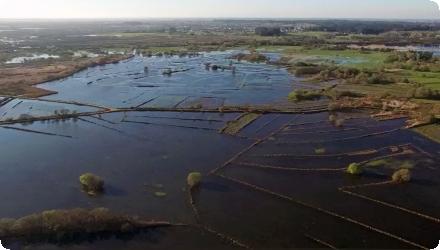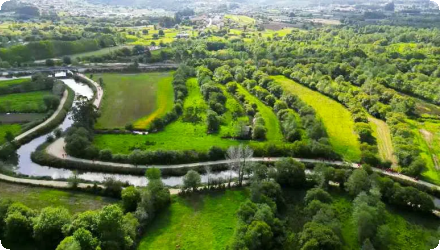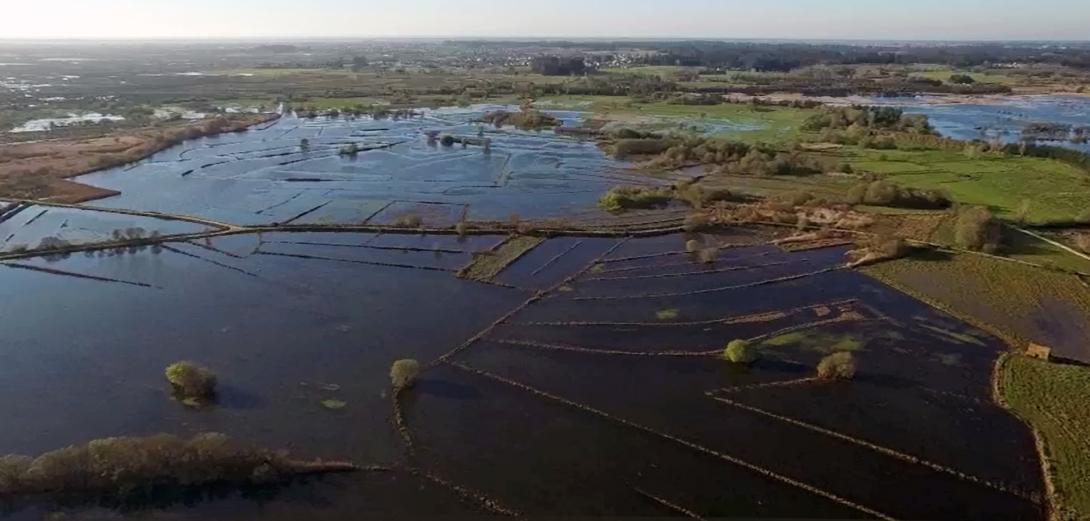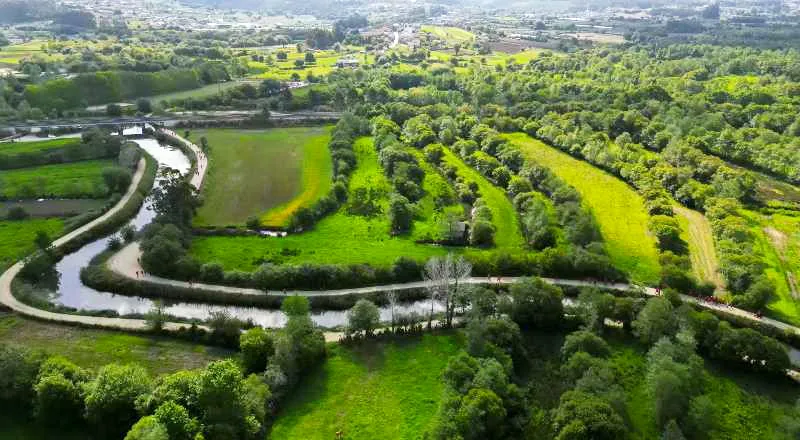Last update
2025
Summary
This is a traditional practice in the Baixo Vouga Lagunar Area (Aveiro District, Vouga River Estuary, Portugal), since 19th century in order to protect BVL from the tidal floods. Baixo Vouga Lagunar represents a man-shaped landscape working in a dependent relationship between agricultural activities, wildlife and water regulation. BVL includes three main landscape units: bocage (smallholdings bounded by living-hedges and water ditches supplying water for crop and livestock production and also assure the drainage when there is water in excess in the fields), wetlands and open-fields.
In recent years, BVL has become a living lab for climate adaptation and resilience strategies, studied through projects such as ADAPT-MED and Man and Nature in the BVL. Local stakeholders recognize the protective role of tidal defense structures, though awareness of climate impacts remains limited. Efforts continue to promote synergies between nature conservation, agriculture and water management. The area is part of the Ria de Aveiro Natura 2000 site and hosts over 170 bird species, reinforcing its ecological value within a multifunctional landscape.
In recent years, BVL has become a living lab for climate adaptation and resilience strategies, studied through projects such as ADAPT-MED and Man and Nature in the BVL. Local stakeholders recognize the protective role of tidal defense structures, though awareness of climate impacts remains limited. Efforts continue to promote synergies between nature conservation, agriculture and water management. The area is part of the Ria de Aveiro Natura 2000 site and hosts over 170 bird species, reinforcing its ecological value within a multifunctional landscape.
Position
Latitude
40.7099019
Longitude
-8.5986756
Project
NWRM
National Id
Portugal_03
Implementation Status
Contact
Marta Rodríguez (IMDEA Water) on the basis of information kindly provided by Ana Lillebø (Universidade de Aveiro) and Ruth Pereira (Universidade do Porto), whose valuable contribution is acknowledged and very much appreciated
RBD code
PTRH4
Transboundary
0
Photo gallery
Location of the project
The project is located in the Baixo Vouga Lagunar area, in the Vouga River estuary, within the municipality of Estarreja, Aveiro District, Portugal.
NUTS Code
PT16 - Centro (PT)
Project's objectives
Restore and preserve the traditional bocage landscape : Maintain the system of living hedges, drainage ditches, and small agricultural plots that support water regulation and biodiversity.
Enhance flood protection : Protect the area from tidal and fluvial flooding.
Promote multifunctional land use.
Improve biodiversity status : Conserve habitats within the Ria de Aveiro Natura 2000 site, which supports over 170 bird species.
Enhance flood protection : Protect the area from tidal and fluvial flooding.
Promote multifunctional land use.
Improve biodiversity status : Conserve habitats within the Ria de Aveiro Natura 2000 site, which supports over 170 bird species.
Involved Partners
| Authority type | Authority name | Role | Comments |
|---|---|---|---|
Climate zone
warm temperate dry
Temperature
14.4
Precipitation
960.6
Annual rainfall range
900 - 1200 mm
Elevation range
3
Vegetation class
The trees are intended to serve as a subdivision of farmland and environmental mitigation (creation of shade, reducing the temperature and increasing humidity). The shrubby vegetation have essentially the function of defense of field crops against the winds.
Forming the living hedges we can fine trees, shrubs and herbaceous vegetation (http://www.biorede.pt/)
The tree community, part of the living hedges, is characterized by alder (Alnus glutinosa), willows (Atrocinerea salix), oak (Quercus robur), silver or white poplar (Populus alba) and laurel (Laurus nobilis).
The shrub layer is represented by hawthorn (Crataegus monogyna), the butcher's broom (Ruscus aculeatus), elderberry (Sambucus nigra), buckthorn (Frangula alnus), roses (Rosa pouzini, Rosa sempervirens) elmleaf blackberry (Rubus ulmifolius).
Regarding the herbaceous community there are standing out climbing plants such as honeysuckle (Lonicera periclymenum), the Bryonia dioica, Morning Glory (Calystegia sepium), and Senecio mikanioides, among others. Vegetation influences the rate and efficiency of storm-water infiltration and filtration.
Forming the living hedges we can fine trees, shrubs and herbaceous vegetation (http://www.biorede.pt/)
The tree community, part of the living hedges, is characterized by alder (Alnus glutinosa), willows (Atrocinerea salix), oak (Quercus robur), silver or white poplar (Populus alba) and laurel (Laurus nobilis).
The shrub layer is represented by hawthorn (Crataegus monogyna), the butcher's broom (Ruscus aculeatus), elderberry (Sambucus nigra), buckthorn (Frangula alnus), roses (Rosa pouzini, Rosa sempervirens) elmleaf blackberry (Rubus ulmifolius).
Regarding the herbaceous community there are standing out climbing plants such as honeysuckle (Lonicera periclymenum), the Bryonia dioica, Morning Glory (Calystegia sepium), and Senecio mikanioides, among others. Vegetation influences the rate and efficiency of storm-water infiltration and filtration.
Water bodies: Ecological Status
Poor
Water bodies: Chemical Status
Good
Project scale
Meso
Project scale specification
The project targets a regional landscape - the Baixo Vouga Lagunar area. The interventions and research span multiple land parcels and ecosystems within the estuarine zone but do not cover an entire large river basin or national territory. Hence, it exceeds micro-scale, but remains within a sub-basin/regional planning scope.
Performance timescale
> 20 years
Project area
1285
Design capacity description
Living-hedges length (year 1995): 167 km,
Draining ditches (mapped +/- 89 km)
Draining ditches (mapped +/- 89 km)
Total cost
unknown
Costs total information
No quantitative data available (note that some of these infrastructures were built in the 19th century).
Costs investment information
No quantitative data available (note that some of these infrastructures were built in the 19th century).
Costs land acquisition unit
€/ha
Financing authorities
Type of funding
EU-funds: Rural development funds
Comments
Multiple projects have received EU funding through: ADAPT-MED: funded by MED Programme (EU Regional Development Fund), previous initiatives have been supported via LIFE, INTERREG, or FP7/H2020.
Compensations
0
Policy context
Need for a tidal flood protection in the region.
Land ownership
Mostly private (bocage farms), some protected/public areas. Ownership is fragmented, reinforcing the need for coordination among multiple stakeholders.
Community involvment
No
Design consultation activity
| Activity stage | Name | Key issues | Comments |
|---|
Policy target
| Target purpose |
|---|
|
Runoff control
|
|
Peak-flow reduction
|
|
Oher Societal Benefits
|
|
Oher Societal Benefits
|
|
Groundwater Recharge
|
Policy pressure
| Pressure directive | Relevant pressure |
|---|
Policy impact
| Impact directive | Relevant impact |
|---|
Requirement directive
| Requirement directive | Specification |
|---|
Requirement directive remarks
- Water Policy - WFD.
- Water Policy - Floods Directive.
- Water Policy - Floods Directive.
Policy challenges requirements
- Environmental Policy: Biodiversity Strategy (incl. Green Infrastructure Policy), NATURA 2000, Habitats Directive, LIFE, Soil Strategy.
- Climate change adaptation policy.
- Regional Policy: Cohesion Funds, ERDF
- Agricultural Policy: CAP, EAFRD
- Climate change adaptation policy.
- Regional Policy: Cohesion Funds, ERDF
- Agricultural Policy: CAP, EAFRD
Contractual arrangements
0
| Arrangement type | Responsibility | Role | Name | Comments |
|---|
Part of wider plan
1
Wider plan type
| Wider plan type | Wider plan focus | Name | Comments |
|---|
Biodiversity : Avifauna. Species diversity and abundance - over 170 bird species mentioned.
Hydrological conditions : Seasonal flooding in bocage fields, Water levels affecting wetlands and ditches.
Stakeholder perception / adaptation readiness : Awareness and perception of climate risk, evaluation of the effectiveness of tidal defense infrastructure.
Hydrological conditions : Seasonal flooding in bocage fields, Water levels affecting wetlands and ditches.
Stakeholder perception / adaptation readiness : Awareness and perception of climate risk, evaluation of the effectiveness of tidal defense infrastructure.
Maintenance
The bocage network of ditches and hedges requires ongoing local maintenance.
Unknown
- Cultivated crops, namely Rice, maize and permanent pastures.
- Reared animals and their outputs , namely Marinhoa cattle for meat; other cattle breeds for meat (Charolais, Limousine, crossbreed); Holstein Friesian cattle for dairy products like milk.
- Reared animals and their outputs , namely Marinhoa cattle for meat; other cattle breeds for meat (Charolais, Limousine, crossbreed); Holstein Friesian cattle for dairy products like milk.
The Marinhoa is an endemic species and is a certified cattle breed for Aveiro region, having an added market value.
The area has a high intrinsic value due to its biodiversity and also due to its representativeness of a sustainable land use type and water management and it could be explored in the future for ecotourism.
The area has a high intrinsic value due to its biodiversity and also due to its representativeness of a sustainable land use type and water management and it could be explored in the future for ecotourism.
Information on retained water
Two management operations—dredging and extension of a flood bank in 2018–2019—had unintended negative impacts. Hydrodynamics: increased tidal prism and water velocity altered turbidity and flow patterns, affecting seagrass and saltmarsh communities. Coastal squeeze: downstream saltmarshes experienced excessively long submersion periods to which they are not well adapted. As part of the AQUACROSS/Ecosystem-Based Management (EBM) planning, participatory modelling identified the need to compensate such impacts by preserving traditional bocage, freshwater channels, and estuarine subtidal channels that provide critical ecosystem services.
The traditional bocage network (hedges + drainage ditches) functions as a water retention and drainage system, reducing flood propagation across ~1,200 ha of farmland.Dike and ditch interventions, including flood bank extension, are intended to prevent tidal and saline intrusion, though they have also generated altered submersion regimes for wetlands.
The traditional bocage network (hedges + drainage ditches) functions as a water retention and drainage system, reducing flood propagation across ~1,200 ha of farmland.Dike and ditch interventions, including flood bank extension, are intended to prevent tidal and saline intrusion, though they have also generated altered submersion regimes for wetlands.
Information on Peak flow rate reduction
Yes, but not quantified
Information on Increased infiltration
Yes, but not quantified
Water quality overall improvements
N/A info
Information on Water quality overall improvements
No quantitative data available (note that some of these infrastructures were built in the 19th century). One can infer that living hedges will enhance the retention of SPM (suspended particulate matter) and associated/adsorbed pollutants, therefore contri
Soil quality overall soil improvements
N/A info
Information on Soil quality overall soil improvements
A 2025 study on paddy soil quality in the BVL assessed pH, organic matter, conductivity, and potentially toxic elements (PTEs):
Soils ranged from moderately to strongly acidic (pH 4.4–5.8), with organic matter up to 34%.
Arsenic (As), Lead (Pb), Uranium (U) in some sites exceeded Portuguese thresholds for agricultural soils.
Cultivated fields had similar copper (Cu) levels; abandoned fields showed elevated As, Pb, U - possibly due to saline intrusion or geogenic sources.
However, porewater and irrigation water carried low PTE concentrations, and rice grains (white, brown, wild) showed PTE levels well below EU food-safety limits.
Soils ranged from moderately to strongly acidic (pH 4.4–5.8), with organic matter up to 34%.
Arsenic (As), Lead (Pb), Uranium (U) in some sites exceeded Portuguese thresholds for agricultural soils.
Cultivated fields had similar copper (Cu) levels; abandoned fields showed elevated As, Pb, U - possibly due to saline intrusion or geogenic sources.
However, porewater and irrigation water carried low PTE concentrations, and rice grains (white, brown, wild) showed PTE levels well below EU food-safety limits.
Information on Soil quality overall soil carbon
Positive impact-SQ improvement
1
Yes, BVL is recognized as model of biodiversity and balance between man activities and wildlife.
The Baixo Vouga Lagunar is integrated in Ria de Aveiro Special Protection Area (SPA – with the Natura 2000 code PTZPE0004). This SPA regularly supports over 1 % of the population of the pied avocet (Recurvirostra avosetta) and 60 % of the population of the purple heron (Ardea purpurea).
Baixo Vouga Lagunar is an important for 173 species of birds, such as the fish-hawk (Pandion haliaetus), the purple heron (Ardea purpurea), the black kite (Milvus migrans), the mallard duck (Anas platyrhynchos) and the white stork (Ciconia ciconia). It is also an important habitat for mammals like the least weasel (Mustela nivalis), the hedgehog (Erinaceus europaeus) and the European otter (Lutra lutra), for amphibians like the common toad (Bufo bufo), the tree frog (Hyla arborea), the fire salamander (Salamandra salamandra), the marbled newt (Triturus marmoratus) and the Iberian Painted Frog (Discoglossus galganoi), for reptiles, namely the Iberian emerald lizard (Lacerta schreiberi) and the viperine water snake (Natrix maura), and for several fish species including the eel (Petromyzon marinus) and the lamprey (Lampetra planeri). According to the EU Directive 92/43/EEC some of these species are classified as "strictly protected" (e.g. the otter and the tree frog). Also for IUCN (International Union for Conservation of Nature), the otter is in the “red list”, classified as “Near Threatened” as well as the Iberian Emerald Lizar
The Baixo Vouga Lagunar is integrated in Ria de Aveiro Special Protection Area (SPA – with the Natura 2000 code PTZPE0004). This SPA regularly supports over 1 % of the population of the pied avocet (Recurvirostra avosetta) and 60 % of the population of the purple heron (Ardea purpurea).
Baixo Vouga Lagunar is an important for 173 species of birds, such as the fish-hawk (Pandion haliaetus), the purple heron (Ardea purpurea), the black kite (Milvus migrans), the mallard duck (Anas platyrhynchos) and the white stork (Ciconia ciconia). It is also an important habitat for mammals like the least weasel (Mustela nivalis), the hedgehog (Erinaceus europaeus) and the European otter (Lutra lutra), for amphibians like the common toad (Bufo bufo), the tree frog (Hyla arborea), the fire salamander (Salamandra salamandra), the marbled newt (Triturus marmoratus) and the Iberian Painted Frog (Discoglossus galganoi), for reptiles, namely the Iberian emerald lizard (Lacerta schreiberi) and the viperine water snake (Natrix maura), and for several fish species including the eel (Petromyzon marinus) and the lamprey (Lampetra planeri). According to the EU Directive 92/43/EEC some of these species are classified as "strictly protected" (e.g. the otter and the tree frog). Also for IUCN (International Union for Conservation of Nature), the otter is in the “red list”, classified as “Near Threatened” as well as the Iberian Emerald Lizar
Ecosystem impact climate regulation
No information available
Information on Ecosystem impact climate regulation
Living hedges will enhance the 1) GHGs storage, including soil carbon; 4) increased permanent biomass. The canopy also enhances the surface area for the settlement of atmospheric PM (particulate matter). In this specific example ‘Bocage’ as green infrastructure reduces the visual impact and the smell from a pulp mill industry
Ecosystem provisioning services
1
Information on Ecosystem provisioning services
Provision of the following services (by means of bocage):
- Cultivated crops, namely Rice, maize, oat, alfalfa, ryegrass and pastures;
- Reared animals and their outputs, namely Marinhoa cattle for meat; other cattle breeds for meat (Charolais, Limousine, crossbreed); Holstein Friesian cattle for dairy products like milk; and equine cattle;
- Wild plants, i.e. Wild berries;
- Fibers and other materials from plants, algae and animals for direct use or processing, namely: Wood, timber, flowers, eucalyptus for industrial products such as cellulose for paper;
- Groundwater for non-drinking purposes;
- Biomass-based energy sources, i.e. ‘Bocage’ living hedges are trimmed for firewood
- Mechanical energy, i.e., Physical labour provided by Marinhoa cattle
- Cultivated crops, namely Rice, maize, oat, alfalfa, ryegrass and pastures;
- Reared animals and their outputs, namely Marinhoa cattle for meat; other cattle breeds for meat (Charolais, Limousine, crossbreed); Holstein Friesian cattle for dairy products like milk; and equine cattle;
- Wild plants, i.e. Wild berries;
- Fibers and other materials from plants, algae and animals for direct use or processing, namely: Wood, timber, flowers, eucalyptus for industrial products such as cellulose for paper;
- Groundwater for non-drinking purposes;
- Biomass-based energy sources, i.e. ‘Bocage’ living hedges are trimmed for firewood
- Mechanical energy, i.e., Physical labour provided by Marinhoa cattle
Key lessons
Bocage requires high maintenance as it gathers not only a living-hedges network but also a hydraulic grid of ditches, channels, floodgates, banks and other water barriers. Some of these infrastructures were built in the 19th century in order to protect BVL from the tidal floods and its lack of maintenance is leading to draining issues and to the increase of salinity. So, these infrastructures are not only a cultural part of the landscape but also functions as a part of an integrate management system. With the increase of the surface salinity intrusion, more tolerant species appear, like bulrushes, rushes and reeds
Infrastructure interventions can have unintended ecological impacts : Engineering works like floodbank extensions and dredging (2018–2019) altered tidal flow regimes, leading to negative impacts on saltmarshes and estuarine habitats. These interventions, while aiming at flood protection, created hydrological imbalances and stress for sensitive biodiversity (e.g. over-submersion of marshes). Even well-intentioned interventions require thorough ecosystem-based impact assessments to avoid degrading key habitats and ecosystem functions.
Awareness and engagement of local stakeholders remain limited : Surveys (ADAPT-MED) show that only 39% of stakeholders felt aware of climate change impacts. There is still low social appropriation of adaptation planning, and many local actors do not perceive visible changes despite ecological data showing otherwise. Long-term adaptation success depends not only on technical solutions but also on social learning, trust-building, and participatory planning.
Multiscale coordination is needed for coherent outcomes : The BVL lies within a Natura 2000 site, under local, regional, and EU-level environmental regulations. Fragmented land ownership and jurisdictional overlap challenge coherent implementation of measures. Aligning local actions with regional and EU-level objectives is key to achieving durable outcomes, especially in multifunctional landscapes.
Infrastructure interventions can have unintended ecological impacts : Engineering works like floodbank extensions and dredging (2018–2019) altered tidal flow regimes, leading to negative impacts on saltmarshes and estuarine habitats. These interventions, while aiming at flood protection, created hydrological imbalances and stress for sensitive biodiversity (e.g. over-submersion of marshes). Even well-intentioned interventions require thorough ecosystem-based impact assessments to avoid degrading key habitats and ecosystem functions.
Awareness and engagement of local stakeholders remain limited : Surveys (ADAPT-MED) show that only 39% of stakeholders felt aware of climate change impacts. There is still low social appropriation of adaptation planning, and many local actors do not perceive visible changes despite ecological data showing otherwise. Long-term adaptation success depends not only on technical solutions but also on social learning, trust-building, and participatory planning.
Multiscale coordination is needed for coherent outcomes : The BVL lies within a Natura 2000 site, under local, regional, and EU-level environmental regulations. Fragmented land ownership and jurisdictional overlap challenge coherent implementation of measures. Aligning local actions with regional and EU-level objectives is key to achieving durable outcomes, especially in multifunctional landscapes.
Success factor(s)
| Success factor type | Success factor role | Comments | Order |
|---|---|---|---|
|
Attitude of decision makers
|
main factor
|
<p>This is a success factor for the maintenance of the infrastructure. Note that some of these infrastructures were built in the 19th century.</p>
|
|
|
Public participation
|
main factor
|
<p>This is a success factor for the maintenance of the infrastructure. Note that some of these infrastructures were built in the 19th century.</p>
|
|
|
Communication activities
|
secondary factor
|
<p>This is a success factor for the maintenance of the infrastructure. Note that some of these infrastructures were built in the 19th century.</p>
|
Driver
| Driver type | Driver role | Comments | Order |
|---|---|---|---|
|
Past flooding events
|
main driver
|
1
|
Transferability
The BVL bocage system is transferable to lowland estuarine or flood-prone areas where multifunctional land use is viable. Success depends on maintaining traditional structures (hedges, ditches), stakeholder engagement, and careful hydrological balance. Attention must be paid to unintended impacts from infrastructure works and to aligning local practices with conservation goals.
English



